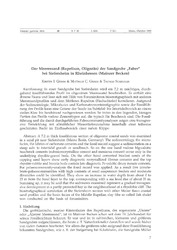Der Meeressand (Rupelium, Oligozän) der Sandgrube „Faber“ bei Siefersheim in Rheinhessen (Mainzer Becken)
Zeitschrift: Mainzer geowissenschaftliche Mitteilungen, 199928: 7 - 32
Grimm, Kirsten I.; Grimm, Matthias C.; Schindler, Thomas, 1999: Der Meeressand (Rupelium, Oligozän) der Sandgrube „Faber“ bei Siefersheim in Rheinhessen (Mainzer Becken). In: Mainzer geowissenschaftliche Mitteilungen, Band 28: 7 - 32, DOI: https://doi.org/10.23689/fidgeo-5574.
 |
Dokument öffnen: |
In einer Sandgrube bei Siefersheim wird ein 7,2 m mächtiges, durchgehend
fossilführendes Profil im oligozänen Meeressand beschrieben. Es enthält eine
diverse Fauna und lässt sich mit Hilfe von Foraminiferen biostratigraphisch mit anderen
Meeressandprofilen und dem Mittleren Rupelton (Fischschiefer) korrelieren. Aufgrund
der Sedimentologie, Mikrofazies und Karbonatzementstratigraphie sowie der Fossilführung
des Profils kann eine Genese der Sande im Subtidal- bis Intertidalbereich an einem
steilen Kies- bis Sandstrand nachgewiesen werden. So treten in den liegenden, kiesigen
Partien des Profils vadose Zementtypen auf, die typisch für Beachrock sind. Die Fossilführung
und die damit durchgeführten Paleocommunityanalysen zeigen eine transgressive
Entwicklung mit allmählicher Wassertiefenzunahme innerhalb einer teilweise
geschützten Bucht im Einflussbereich einer nahen Klippe. Abstract: A 7.2 m thick fossiliferous section of oligocene coastal sands was examined
in a sand pit near Siefersheim (Mainz Basin, Germany). The sedimentology, the microfacies,
the fabrics of carbonate cements and the fossil record suggest a sedimentation on a
steep sub- to intertidal gravel- or sandbeach. So on the one hand vadose Mg-calcitic
beachrock cements (submicrocrystalline cement and meniscus cement) occur only in the
underlying rhyolite-gravel beds. On the other hand cemented bioclast sands of the
capping sand layers show early diagenetic recrystallized fibrous cements and the top
rhyolite-rubble and breccia beds contain late diagenetic Fe-calcitic drusy mosaic cements.
For palaeocommunity-analysis the fossil record was applied. As a result five invertebrate-
palaeocommunities with high contents of sessil suspension feeders and moderate
diversities could be identified. They show an increase in water depth from about 0 to
25 m from the basal layer to the top, corresponding with a sea level rise of about 35 m.
Summing up, it may be said that the sediments examined represent a gradual transgressive
development in a partly protected bay in the neighbourhood of a rhyolithic cliff. The
biostratigraphical correlation of the Siefersheim section with other Mainz Basin coastal
sand profiles and the basin facies of the Middle Rupelian clay (the so called fish shale)
was conducted on the basis of foraminifers.

